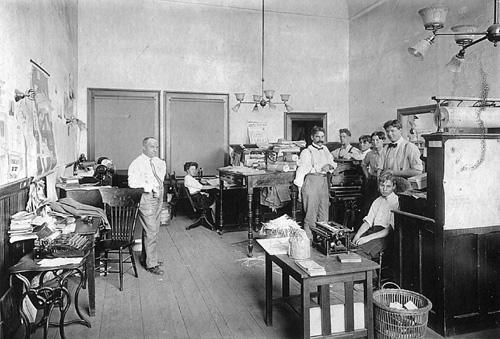
When John McGonigle walked into his offices at the corner of San
Benito Street and Brigg’s Alley on Oct. 18, 1873, little did he
know he would be giving birth to a local tradition that has
recorded the entire 130-year history of San Benito County.
Originally named The Hollister Enterprise, the paper that would
become The Free Lance started nearly four months before
disenfranchised residents of Hollister and San Juan Bautista broke
away from Monterey County and formed what is now San Benito County.
This was just one year after Hollister was officially incorporated
as a city.
When John McGonigle walked into his offices at the corner of San Benito Street and Brigg’s Alley on Oct. 18, 1873, little did he know he would be giving birth to a local tradition that has recorded the entire 130-year history of San Benito County.
Originally named The Hollister Enterprise, the paper that would become The Free Lance started nearly four months before disenfranchised residents of Hollister and San Juan Bautista broke away from Monterey County and formed what is now San Benito County. This was just one year after Hollister was officially incorporated as a city.
The Enterprise was not Hollister’s first newspaper or even its second source of news.
The Central Californian, which started in San Juan Bautista in 1869 and later moved to a building at the corner of Fourth and Monterey streets, was the first. In August 1871, however, the paper moved to Salinas and was renamed the Salinas City Index, the predecessor of today’s Salinas Californian.
Hollister’s second newspaper was the Hollister Advance, which was established by William Shaw on March 15, 1872, although it later became part of the Free Lance.
In August 1875, with the creation of the Hollister Telegraph by George Carleton, The Enterprise, Advance and the Telegraph engaged in a bitter editorial battle.
That battle spilled over from the editorial pages and into the courtroom when Carleton shot and killed the Enterprise’s editor Sylvan H. Brummet Sr. on the steps of the San Benito County Courthouse.
Carleton was later acquitted in a trial that was transferred to Santa Clara County.
It was after the trial that two of the warring papers would find themselves changing ownership in rapid succession.
Brummet’s death led to the sale of the Enterprise and the Telegraph to Maj. John S. Hay on Feb. 5, 1881. Hay combined the two papers and renamed them The Pacific Coast.
But Hay soon sold the Coast to brothers W.J. and A.J. Jones, who renamed it the Democrat. About a year or two later, the Joneses sold the paper to former Superior Court Judge Maurice Dooling and James A. Kearny in 1884.
Shortly after that, the paper was sold again to Lester Baldwin and Robert Shaw who renamed the paper The Evening Free Lance.
The name Free Lance was derived from its logo of an knight errant riding his trusty steed and wielding his lance. In the days of chivalry, the knight errant was a knight who owed allegiance to no king, which meant he was free to use his lance to strike at injustice and tyranny wherever he found it. The name and the ideals it embodied have been a part of the newspaper ever since.
The Free Lance, however, did not become a daily newspaper until 1910.
In September 1911, a young man named Millard F. Hoyle joined the Free Lance staff as a business manager. By 1917, Hoyle had become the sole owner of the Free Lance.
Ten months later, Hoyle bought the Hollister Bee from F. P. Royle.
In 1937, Hoyle bought the Hollister Advance from Walter Keene. Hoyle ran the Advance as a weekly edition for rural areas and out of state residents until 1986.
When Hoyle died while visiting Havana, Cuba in May 1941, his son Millard Hoyle Jr., a Stanford alumnus, took over as publisher of the paper. Hoyle Jr., who also served as director of the California Newspaper Publisher’s Association, maintained control of the family owned newspaper until his death on Aug. 23, 1986, shortly after his retirement as president of Hollister Newspapers Inc.
It was Hoyle Jr. who moved the Free Lance’s operations in September 1960 to its current location on Sixth Street, which is the paper’s fifth home since it was founded 130 years ago.
After Hoyle’s death in 1986, the paper was sold to the McClatchy Newspaper chain, which had just acquired The Gilroy Dispatch and Morgan Hill Times.
In April 1987, The Free Lance changed from afternoon delivery to early morning delivery for the first time in the paper’s history.
In 1997, McClatchy sold the Free Lance, the Dispatch and the Times to the U.S. Media Newspaper chain, which switched the three papers back to afternoon delivery.
In 2001, the operation and management of the newspapers was transferred to Pacific-Sierra Publishing Inc., a company that owns and operates 17 newspapers and publications throughout California.
Pacific-Sierra Publishing Inc. continues to publish all three award-winning daily newspapers with Publisher Bill Barry at the helm and Associate Publisher/Executive Editor Mike Fitzgerald at the Free Lance.
In 2002, the Free Lance, the Dispatch and the Times won a total of 13 awards from the California Newspaper Publishers Association’s better newspaper contest, which included awards for general excellence, editorials, sports and entertainment writing.









